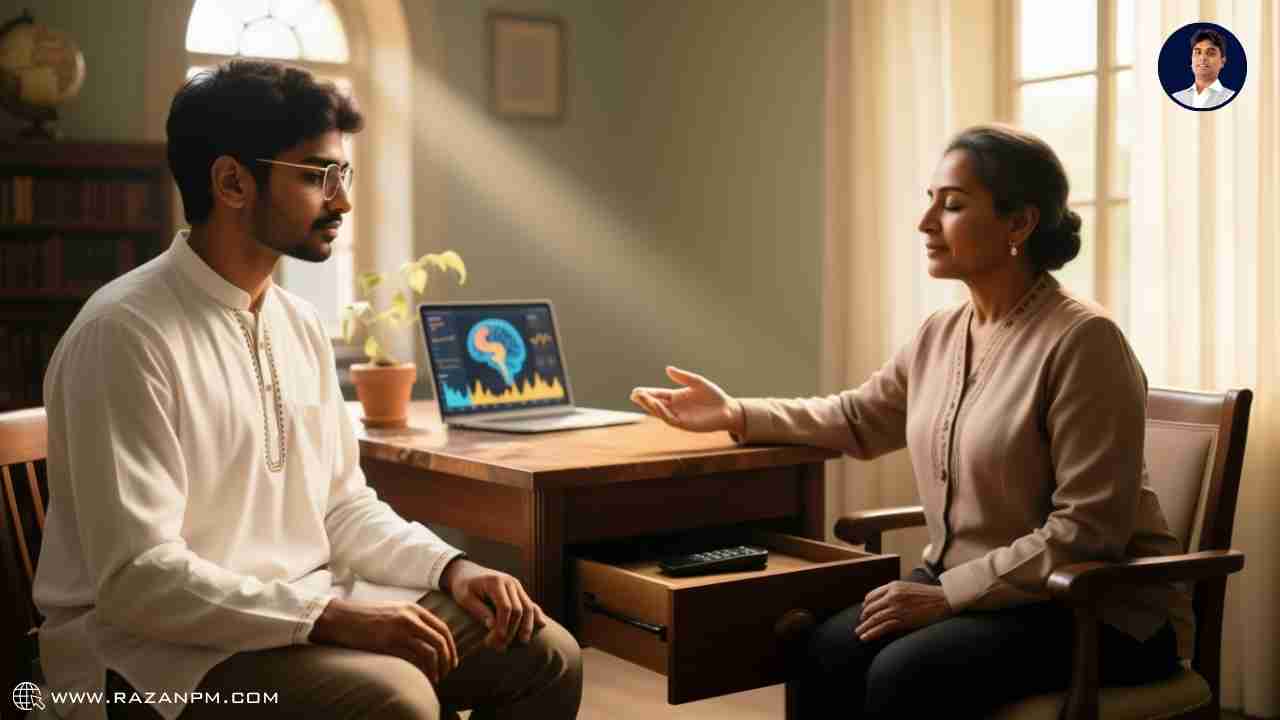When a "Hi" becomes a headache…
Ever noticed how a simple “Hey, what’s up?” ping on WhatsApp can spiral into an hour-long chain of unnecessary chats? And before you know it, you’re replaying the last seen status, overthinking the double blue ticks, and wondering “Did I say something wrong?”
Welcome to the modern mental trap — constant digital talk. What starts as casual scrolling or replying can slowly lead to negative thoughts, anxiety, and even emotional trauma. And trust me, you’re not alone.
also read: how to read body language signs indaily life?
We live in an age where silence feels awkward, and notifications feel normal. The constant stream of messages, memes, voice notes, and reels keeps us tied to our screens. On the surface, it looks like connection. But dig deeper, and you’ll see:
It’s not just digital overload. It’s a psychological cage that impacts self-esteem, focus, and emotional health.
also read: 8 signs of hidden depression incancer survivors
Many of my clients tell me:
Sounds familiar? Maybe you’re smiling and thinking, “Arre yeh toh main hoon!” (This is literally me). Don’t worry, this is more common than you think.
also read: 12 behaviors that reveal a man issexually frustrate

also read: 9 hidden signs she misses physicalaffection
From a clinical psychology perspective:
The science is clear: our brain’s reward system (dopamine release) is hijacked by constant notifications. Every ping feels like a reward — even if it’s just a “k” reply. Over time, this rewires your brain to seek validation and activity from digital talk, leading to stress, anxiety, and dependency.
also read: why gen z cant sleep anymore and theoverthinking trap?

A 2019 study in the Journal of Behavioral Addictions found that excessive messaging apps use correlates strongly with anxiety and sleep issues.
Research from the American Psychological Association shows screen overuse reduces attention span and increases stress hormones.
A survey in India (2022) revealed 72% of young adults feel “mentally tired” due to constant digital talk, yet only 12% take active digital detox steps.
In short: Science backs what your heart already knows — too much digital chatter is toxic.
also read: 12 things women do when theyre touchdeprived
Years ago, I had a young client who was bright, funny, and ambitious. But she came to me saying, “Ma’am, I feel trapped. I can’t stop replying to people, even at 2 AM. I’m tired, but I can’t disconnect.”
Her story struck me. I saw her confidence melting under the weight of constant notifications. She wasn’t addicted to talking. She was addicted to being available.
That’s when I began to deeply study how NLP (Neuro-Linguistic Programming) can rewire communication patterns. By shifting her internal language (“I have to reply” → “I choose when to reply”), she regained control. Within months, she slept better, felt calmer, and reconnected with her real goals.
And honestly, that moment changed me too. I realized — we don’t have to escape people, we just have to escape the trap.
also read: why gen z cant sleep anymore and theoverthinking trap?

👉 The “Pause and Label” Technique
1. Next time a notification pops up, don’t touch your phone immediately.
2. Pause for 5 seconds. Take a deep breath.
3. Ask yourself: “Is this urgent, or is it habit?”
4. Label it:
This tiny pause helps you break the automatic loop. Your brain learns that not every ping deserves your energy instantly.
Try this for 3 days and you’ll see — the world doesn’t fall apart if you reply later. But your mental peace starts to come back.
also read: why couples feel unheard and how tofix it fast
Of course, one trick won’t fix the deeper wiring. The real solution involves:
These require guided steps and personalized strategies — something beyond what a single blog can fully cover. But this blog is your first baby step toward freedom.
also read: why generational habits shape how weescape?
If you’re nodding while reading this, please remember — you don’t have to figure it out alone. Many people silently suffer in the loop of digital talk. But with the right psychological tools and NLP strategies, you can absolutely break free.
If this feels familiar, let’s talk. Together, we can create a plan tailored for your life and challenges.
👉 Book your consultation here — A safe space to pause, breathe, and begin your journey to real freedom.
👉 Begin Your Journey with a 1 on 1 Consultation
👉 Begin Your Journey with a 1 on 1 Consultation

A: Digital talk overload occurs when constant messaging, notifications, and online interactions start affecting your mental health, focus, and sleep.
A: Signs include compulsive checking, anxiety when messages are unanswered, irritability, sleep disturbances, and emotional dependency on digital responses.
also read: 8 emotional changes in women withoutintimacy
A: Yes! NLP techniques help reframe your internal dialogue, create boundaries, and reduce compulsive reactions to digital notifications.
A: Start with mini steps like the “Pause and Label” technique, setting screen-free periods, disabling unnecessary notifications, and limiting night-time phone usage.
also read: why chronic disease brings more thanjust pain?
A: Excessive online communication can trigger anxiety, negative thoughts, sleep disturbances, and emotional fatigue, as supported by DSM-5 and ICD-11 guidelines.
A: With consistent mini-strategies and NLP-based techniques, many people notice reduced stress and improved focus within 1–3 weeks.
A: If digital talk is causing anxiety, mood swings, sleep loss, or affecting your daily functioning, it’s best to consult a clinical psychologist for guided strategies.
also read: why actions speak louder than wordsin relationships?
